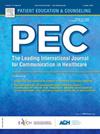Barriers and facilitators in access to reproductive health services for sexual and gender minority populations in the United States: A focus group study
IF 2.9
2区 医学
Q2 PUBLIC, ENVIRONMENTAL & OCCUPATIONAL HEALTH
引用次数: 0
Abstract
Objective
This study aimed to identify facilitators and barriers among sexual and gender minority (SGM) individuals in receiving reproductive healthcare.
Methods
Participants were recruited through social media and university groups across the US. Inclusion criteria consisted of self-identified SGM community members; aged 18–40. This included: cisgender women whose sexual orientation included gay, lesbian, bisexual, and/or queer and / or individuals whose gender identity does not align with their sex assigned at birth; transgender men, non-binary people with a uterus, cisgender queen woman, and transgender woman. An initial codebook was developed utilizing inductive coding to identify key themes.
Results
A total of 9 focus groups were held with 67 people,5–10 people per group. Six themes were identified: 1) Barriers to high quality reproductive care, 2) Facilitators to high quality reproductive care, 3) Negative prior experiences, 4) Physical/logistical access to adequate care, 5) Emotions/trust in disclosing SGM status, and 6) Knowledge levels on SGM reproductive healthcare.
Conclusion
Quality reproductive health care for SGM individuals is hindered by individual, clinician, and institutional factors. The factors include individual barriers of knowledge, distrust, and dysphoria; clinician barriers knowledge gaps or discomfort; and institutional factors of false advertising of LGBTQ+ friendly practices.
Practice implications
This study impacts clinical practice through providing focused areas to better improve training and education for healthcare providers. Findings support improving clinical training on cultural humility, creating a welcoming environment, maintaining trust, and utilizing sensitive terminology.
美国性少数群体和性别少数群体获得生殖健康服务的障碍和促进因素:焦点小组研究
目的本研究旨在确定性少数和性别少数(SGM)个体在接受生殖保健方面的促进因素和障碍。方法通过美国各地的社交媒体和大学团体招募参与者。纳入标准包括自我认定的SGM社区成员;享年18-40。这包括:性取向包括男同性恋、女同性恋、双性恋和/或酷儿的顺性女性和/或性别认同与出生性别不一致的个体;变性人,有子宫的非二元人,顺性别女王,变性人。利用归纳编码开发了一个初始密码本来识别关键主题。结果共开展9个焦点组,67人,每组5-10人。确定了六个主题:1)高质量生殖保健的障碍,2)高质量生殖保健的促进因素,3)负面的先前经历,4)获得适当护理的物理/后勤渠道,5)披露SGM状态的情绪/信任,以及6)SGM生殖保健的知识水平。结论SGM个体的生殖健康服务质量受到个体、临床和体制因素的影响。这些因素包括个人的知识障碍、不信任和焦虑;临床医生障碍、知识差距或不适;LGBTQ+ 友好实践虚假广告的制度因素。实践意义本研究通过提供重点领域来更好地改善医疗保健提供者的培训和教育,从而影响临床实践。研究结果支持在文化谦逊、创造友好环境、保持信任和使用敏感术语方面改进临床培训。
本文章由计算机程序翻译,如有差异,请以英文原文为准。
求助全文
约1分钟内获得全文
求助全文
来源期刊

Patient Education and Counseling
医学-公共卫生、环境卫生与职业卫生
CiteScore
5.60
自引率
11.40%
发文量
384
审稿时长
46 days
期刊介绍:
Patient Education and Counseling is an interdisciplinary, international journal for patient education and health promotion researchers, managers and clinicians. The journal seeks to explore and elucidate the educational, counseling and communication models in health care. Its aim is to provide a forum for fundamental as well as applied research, and to promote the study of organizational issues involved with the delivery of patient education, counseling, health promotion services and training models in improving communication between providers and patients.
 求助内容:
求助内容: 应助结果提醒方式:
应助结果提醒方式:


